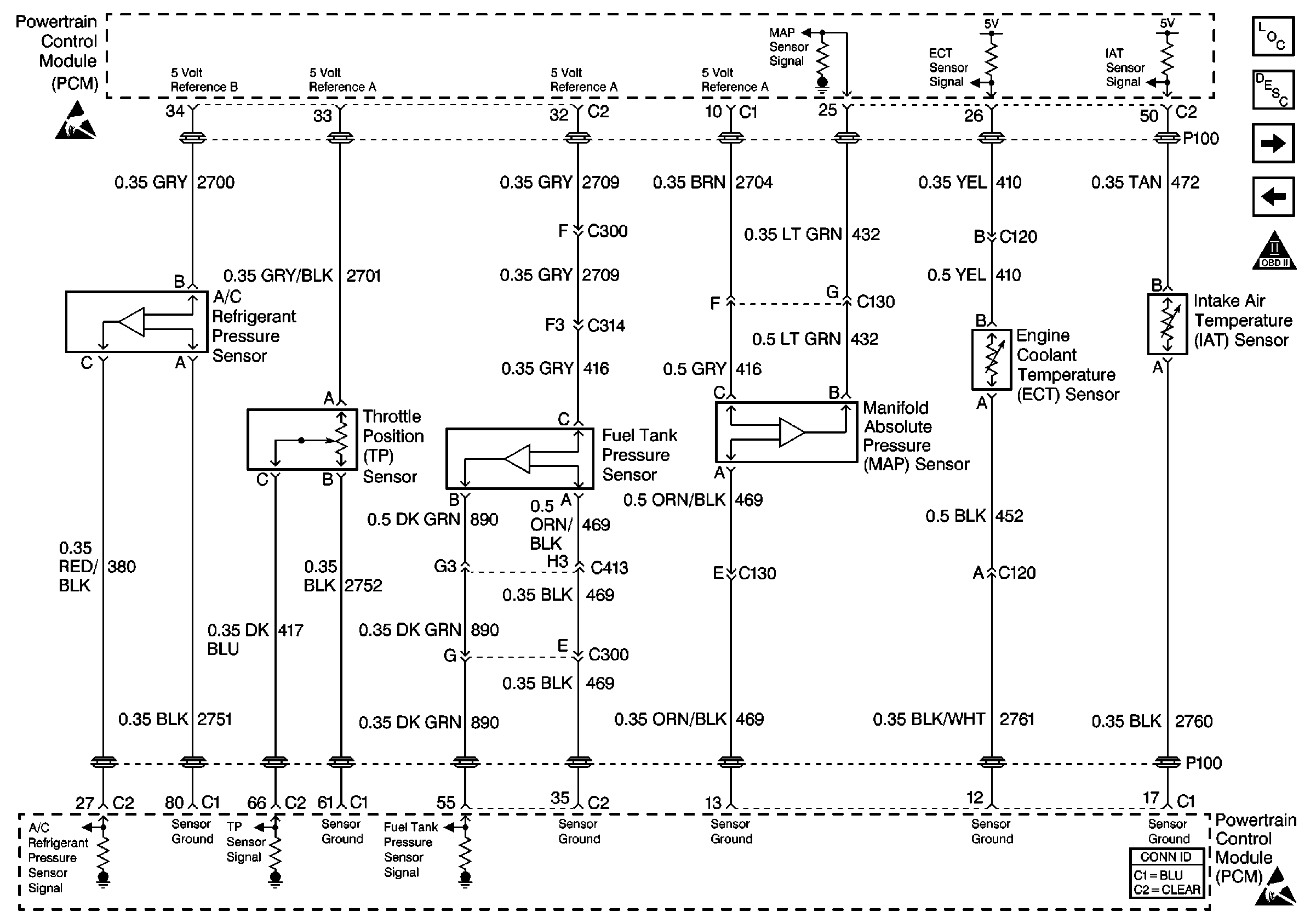Refer to Engine Controls Schematic
Cell 21: Engine Data Sensors

.
Circuit Description
The PCM uses the 5 Volt Reference B circuit as a sensor feed to the following sensors:
| • | The A/C Pressure sensor. |
| • | Fuel Tank Pressure (FTP) Sensor |
The PCM monitors the voltage on the 5 Volt Reference B circuit. If the voltage is out of tolerance, the PCM will set DTC P1639.
Conditions for Running the DTC
The ignition is on.
Conditions for Setting the DTC
| • | The PCM detects a voltage out of tolerance condition on the 5 Volt Reference B circuit. |
| • | Above condition for longer than 10 seconds. |
Action Taken When the DTC Sets
The PCM stores conditions which were present when the DTC set as Failure Records only. This information will not be stored as Freeze Frame Records.
Conditions for Clearing the MIL/DTC
| • | The DTC becomes history when the conditions for setting the DTC are no longer present. |
| • | The history DTC clears after 40 malfunction free warm-up cycles. |
| • | The PCM receives a clear code command from the scan tool. |
Diagnostic Aids
Inspect for the following conditions:
Many situations may lead to an intermittent condition. Perform each inspection or test as directed.
Important: : Remove any debris from the connector surfaces before servicing a component. Inspect the connector gaskets when diagnosing or replacing a component. Ensure that the gaskets are installed correctly. The gaskets prevent contaminate intrusion.
| • | Loose terminal connection |
| - | Use a corresponding mating terminal to test for proper tension. Refer to Testing for Intermittent Conditions and Poor Connections , and to Connector Repairs in Wiring Systems for diagnosis and repair. |
| - | Inspect the harness connectors for backed out terminals, improper mating, broken locks, improperly formed or damaged terminals, and faulty terminal to wire connection. Refer to Testing for Intermittent Conditions and Poor Connections , and to Connector Repairs in Wiring Systems for diagnosis and repair. |
| • | Damaged harness--Inspect the wiring harness for damage. If the harness inspection does not reveal a problem, observe the display on the scan tool while moving connectors and wiring harnesses related to the sensor. A change in the scan tool display may indicate the location of the fault. Refer to Wiring Repairs in Wiring Systems for diagnosis and repair. |
| • | Inspect the powertrain control module (PCM) and the engine grounds for clean and secure connections. Refer to Wiring Repairs in Wiring Systems for diagnosis and repair. |
If the condition is determined to be intermittent, reviewing the Snapshot or Freeze Frame/Failure Records may be useful in determining when the DTC or condition was identified.
Test Description
The numbers below refer to the step numbers on the diagnostic table.
-
Important: : DTC must have failed this ignition to be properly diagnosed.
The 5 Volt Reference circuits have multiple PCM pins, be sure to test all components on the 5 Volt Reference B circuits only.
-
The 5 Volt Reference circuits have multiple PCM pins, be sure to test all components on the 5 Volt Reference B circuits only.
-
This vehicle is equipped with a PCM which utilizes an Electrically Erasable Programmable Read Only Memory (EEPROM). When the PCM is being replaced, the new PCM must be programmed.
Step | Action | Value(s) | Yes | No | ||||
|---|---|---|---|---|---|---|---|---|
1 | Did you perform the Powertrain On-Board Diagnostic (OBD) System Check ? | -- | ||||||
|
Important: : The DTC must have failed this ignition to be diagnosed correctly.
Does the voltage measure near the specified value? | 5.0 V | |||||||
With a DMM observe the voltage while disconnecting all components connected to the 5 Volt Reference circuit one at a time. Does voltage change when one of the components is disconnected? | -- | |||||||
4 | Does the voltage measure less than the specified value? | 4.9 V | ||||||
5 |
Does the voltage measure near the specified value? | 5.0 V | ||||||
6 | Test all 5 Volt Reference A circuits for a short to ground. Refer to Wiring Repairs in Wiring Systems. Did you find and correct the condition? | -- | ||||||
7 | Test all 5 Volt reference A circuit for a short to voltage. Refer Wiring Repairs in Wiring Systems. Did you find and correct the condition? | -- | ||||||
8 | Replace the affected component. Refer to appropriate component replacement. Did you complete the replacement? | -- | -- | |||||
|
Important: : The replacement PCM must be programmed. Replace PCM. Refer to Powertrain Control Module Replacement/Programming . Did you complete the replacement? | -- | -- | ||||||
10 | Use the scan tool in order to clear the DTCs Operate the Vehicle within the conditions for running the DTC as specified in the supporting text . Does the DTC reset ? | -- | System OK |
